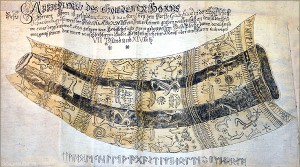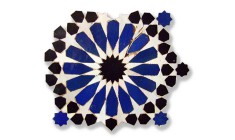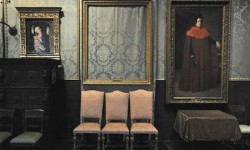Golden Horns of Gallehus

The original Golden Horns of Gallehus, unique Bronze Age artefacts, were stolen and melted down in 1802, causing national uproar in Denmark and even inspiring a famous poem. In 2007, the replicas of the originals were also stolen.
[Originally published on Aug 2, 2012 @ 10:39]
The Golden Horns (guldhornene), two spectacular artefacts dating from the 5th Century AD, were discovered in Gallehus, near to Møgeltønder in southern Jutland. Both were found ‘by accident’ by peasants, the first in 1639, and the second in 1734 (Eskildsen 2012: 44). They were made of gold, and were decorated with runic inscriptions and animal, human and geometric designs, likely representing ‘scenes from religious rituals, seasonal festivals or myths’ (British Museum 2012).
For years, the first horn was kept in the royal palace (Klindt-Jensen 1975: 25), and when the second horn was found, its discovery contributed to a ‘general upsurge of interest in prehistory’ in Denmark, and was one of several finds that contributed to a review of treasure trove law in Denmark (Klindt-Jensen 1975: 33).
By the time of the beginning of the Nineteenth Century, both horns were key exhibits in the Kunstkammer (Royal Collection) at Christiansborg palace in Copenhagen (Klindt-Jensen 1975: 46-47). On 4 May 1802, the Golden Horns were stolen (Klindt-Jensen 1975: 47) by a goldsmith named Niels Heidenreich (Eskildsen 2012: 45). Apparently, the theft had been possible after the thief had befriended the Kunstkammer keeper and secretly borrowed the key to make a copy of it. He was then able to let himself in and take the horns (Klindt-Jensen 1975: 47). The robbery was not made public until 7 May, and the thief had apparently been ‘indiscreet enough to begin selling large quantities of clasps, Indian coins and other fakes manufactured from the gold of the melted down horn’’ (Klindt-Jensen 1975: 47). Heidenreich was arrested a year later (Olsen 2004), and spent almost forty years in prison for his crime (Reuters 2007).
The impact of this loss, seen as a ‘catastrophe’ both then and now (Royal Jelling Museum Curator Michael Andersen quoted in USA Today 2007), led to the composition of a poem by Adam Gottlob Oehlenschläger (also the writer of the Danish national anthem), which mythologised the loss of the horns (Eskildsen 2012: 44). The poem and the story of the loss of the horns is still studied in Danish schools (CBC News 2007; Olsen 2004), and the Golden Horns themselves have been one of a small number of artefacts and monuments that have come to be used to symbolise Danish national identity and patriotism (Sørensen 1996: 36).
Replicas larger than the originals were made of the horns in 1859-60 (National Museum of Denmark 2012a), with a further set of the correct size made in 1979, based on police reports from 1804 (USA Today 2007) and drawings which also survived from before their destruction (Jennbert 2004: 161). However, several casts that were made of the horns have also been lost, leading to an unavoidable degree of uncertainty regarding the exact appearance of the original horns (National Museum of Denmark 2012b).
Remarkably in 2004, a pair of golden earrings believed to have been made by Heidenreich from the prehistoric gold of the horns were donated to the National Museum of Denmark (Olsen 2004). These are currently displayed along with both sets of replica horns in the museum in Copenhagen, while another set of earrings made from the original horns are displayed in the Museum at Ringe, on Funen (Fyn) (National Museum of Denmark 2012c).
Even more recently, theft occurred again when early one morning in September 2007 the 1970s replicas were stolen from the Royal Jelling Museum while on temporary exhibition there (CBC News 2007; Reuters 2007; USA Today 2007). On this occasion however, the thieves were caught soon after and the horns were recovered, although one of the horns was damaged by saw marks. A large gold neck ring stolen at the same time had been broken into pieces, some of which are still missing (National Museum of Denmark 2012d).
The impact of the loss of the original Golden Horns has been credited with contributing to the Romantic movement in the North (Klindt-Jensen 1975: 47) at a time when prehistory generally was becoming significant for nationalism in Denmark (Diaz-Andreu and Champion 1996: 4). Conversely, it has also been suggested that the nature of the theft in 1802, with the subsequent melting of the horns for their gold content, may hint at why ‘so few of the precious sacred objects have come down to us’ (Pettazzoni 1946: 143). However, a more lighthearted approach to the loss of the iconic pieces of Danish cultural heritage has recently been adopted by the National Museum, with a downloadable game on the museum’s website available, based on the original theft (http://natmus.dk/besoeg-museerne/nationalmuseet/spil-guldhornstyven/).
References
British Museum, The (2012), ‘Reproductions of the Gallehus Horns’, http://www.britishmuseum.org/explore/highlights/highlight_objects/pe_mla/r/reproductions_of_the_gallehus.aspx, accessed 26/07/2012.
CBC News (2007), ‘Thieves nab Denmark’s Golden Horns in early morning robbery’, CBC News,18th September 2007, http://www.cbc.ca/news/world/story/2007/09/18/theft-horn-denmark.html, accessed 26/07/2012.
Diaz-Andreu, Margarita and Champion, Timothy (1996), ‘Nationalism and archaeology in Europe: an introduction’, in Margarita Diaz-Andreu and Timothy Champion (eds.), Nationalism and archaeology in Europe (London: UCL Press Ltd), 1-23.
Eskildsen, Kasper Risbjerg (2012), ‘The Language of Objects: Christian Juergensen Thomsen’s Science of the Past’, Isis, 103, 24-53.
Jennbert, Kristina (2004), ‘Sheep and goats in Norse paganism’, Conference at the Swedish Institute in Rome (Proceedings of the conference at the Swedish Institute in Rome; Rome: The Swedish Institute in Rome).
Klindt-Jensen, Ole (1975), A History of Scandinavian Archaeology (London: Thames and Hudson).
National Museum of Denmark (2012), ‘The Golden Horns’, http://natmus.dk/en/historisk-viden/danmark/moeder-med-danmarks-oldtid/the-late-iron-age/the-golden-horns/, accessed 31/07/2012.
— (2012), ‘A vanished world of motifs’, http://natmus.dk/en/historisk-viden/danmark/moeder-med-danmarks-oldtid/the-late-iron-age/the-golden-horns/a-vanished-world-of-motifs/, accessed 31/07/2012.
— (2012), ‘The theft of the Golden Horns’, http://natmus.dk/en/historisk-viden/danmark/moeder-med-danmarks-oldtid/the-late-iron-age/the-golden-horns/the-theft-of-the-golden-horns/, accessed 31/07/2012.
— (2012), ‘The drama continues’, http://natmus.dk/en/historisk-viden/danmark/moeder-med-danmarks-oldtid/the-late-iron-age/the-golden-horns/the-drama-continues/, accessed 31/07/2012.
Olsen, Jan M (2004), ‘Lost and found: from golden horns to teardrop-shaped jewellery’, Athens News, 24 August 2004, http://www.athensnews.gr/old_issue/13088/11860, accessed 31/07/2012.
Pettazzoni, Rafaele (1946), ‘The Pagan Origins of Three-Headed Representation of the Christian Trinity’, Journal of the Warburg and Courtauld Institutes, 9, 135-51.
Reuters (2007), ‘Gilded horns stolen in Denmark, copies of 5th century’, Reuters.com, 17 September 2012, http://www.reuters.com/assets/print?aid=USL1732787420070917, accessed 26/07/2012.
Sorensen, Marie Louise Stig (1996), ‘The fall of a nation, the birth of a subject: the national use of archaeology in nineteenth-century Denmark’, in Margarita Diaz-Andreu and Timothy Champion (eds.), Nationalism and archaeology in Europe (London: UCL Press Ltd), 24-47.
USA Today (2007), ‘Danish golden horns stolen again’, USA Today, 17 September 2007, http://www.usatoday.com/news/world/2007-09-17-3504626872_x.htm, accessed 26/07/2012.


